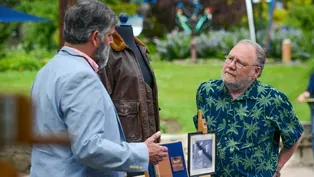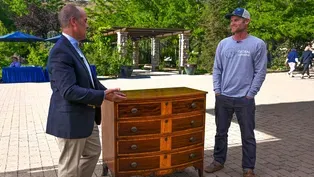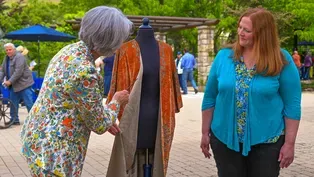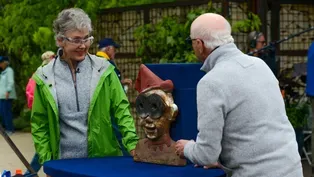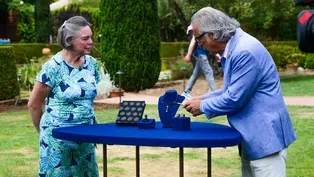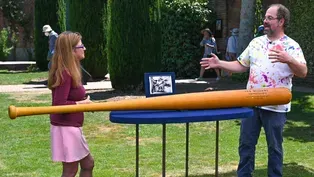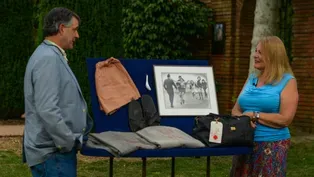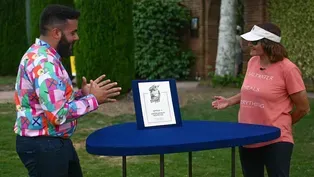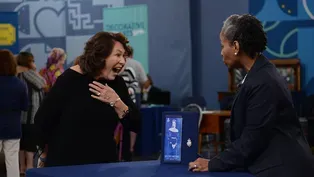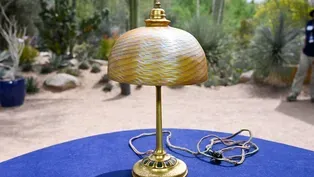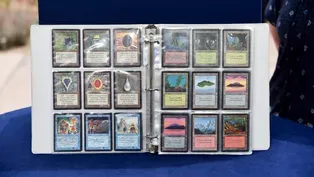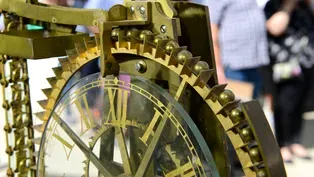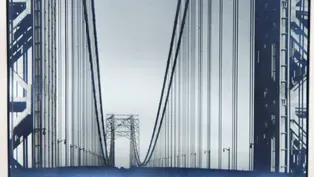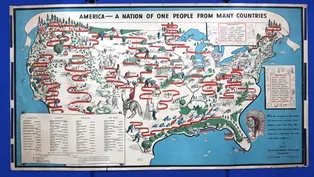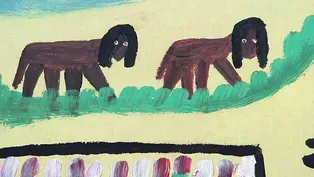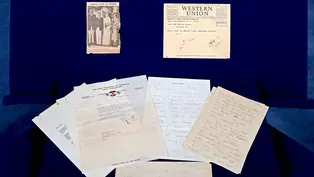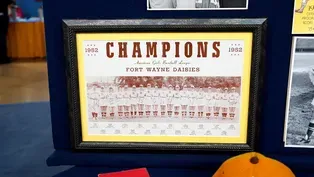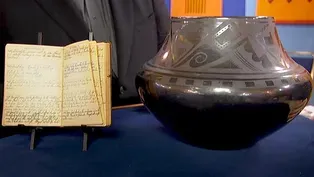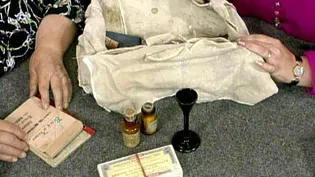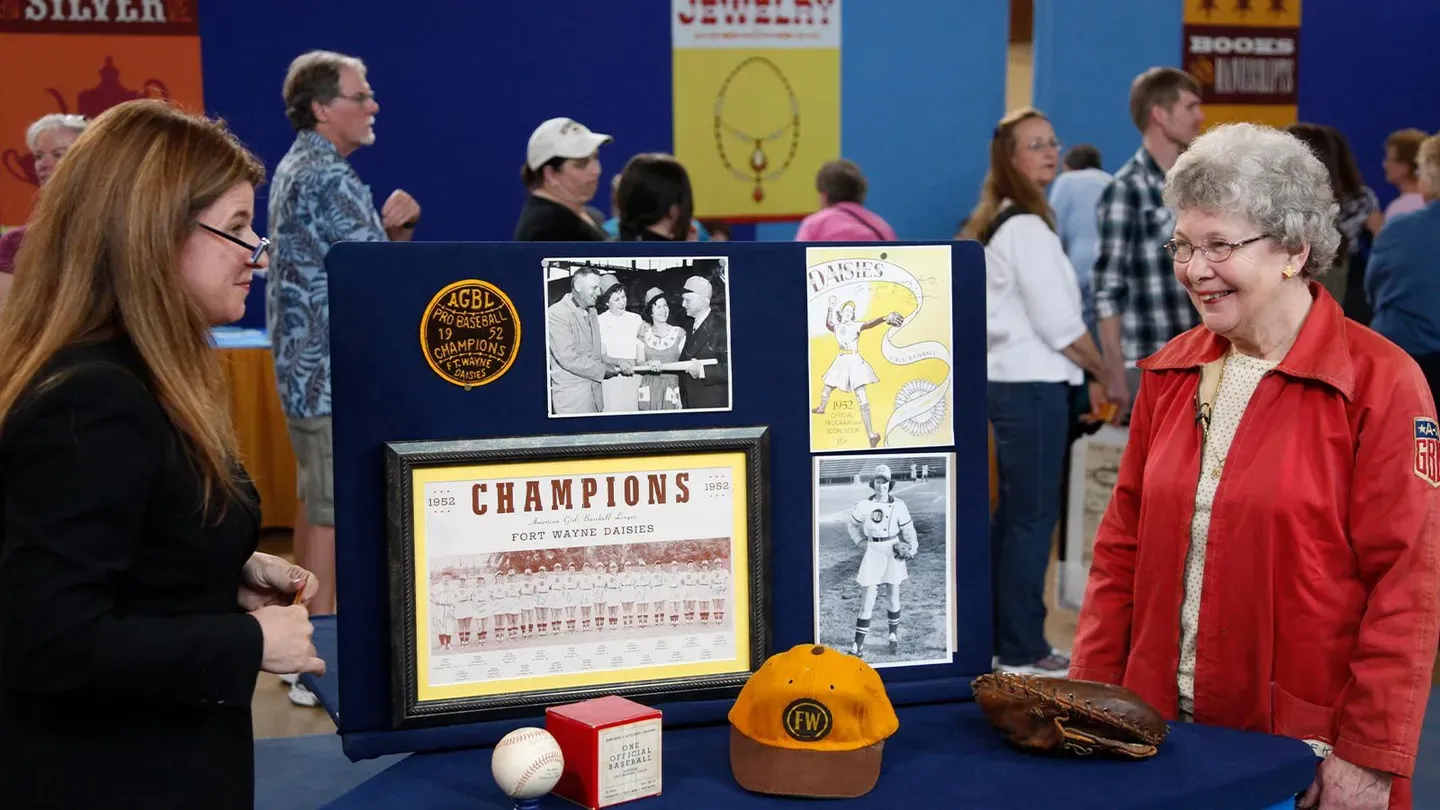

RECUT: Women's Work, Part 1
Special | 22m 28sVideo has Closed Captions
Celebrate trailblazing women who left a mark on the world in this half-hour special!
Celebrate trailblazing women who left a lasting mark on the world in this half-hour special episode! Treasures include a Ruth Muskrat Bronson archive, a Girls Pro Baseball League collection, and a 1933 Margaret Bourke-White photograph.
Funding for ANTIQUES ROADSHOW is provided by Ancestry and American Cruise Lines. Additional funding is provided by public television viewers.

RECUT: Women's Work, Part 1
Special | 22m 28sVideo has Closed Captions
Celebrate trailblazing women who left a lasting mark on the world in this half-hour special episode! Treasures include a Ruth Muskrat Bronson archive, a Girls Pro Baseball League collection, and a 1933 Margaret Bourke-White photograph.
How to Watch Antiques Roadshow
Antiques Roadshow is available to stream on pbs.org and the free PBS App, available on iPhone, Apple TV, Android TV, Android smartphones, Amazon Fire TV, Amazon Fire Tablet, Roku, Samsung Smart TV, and Vizio.
Buy Now
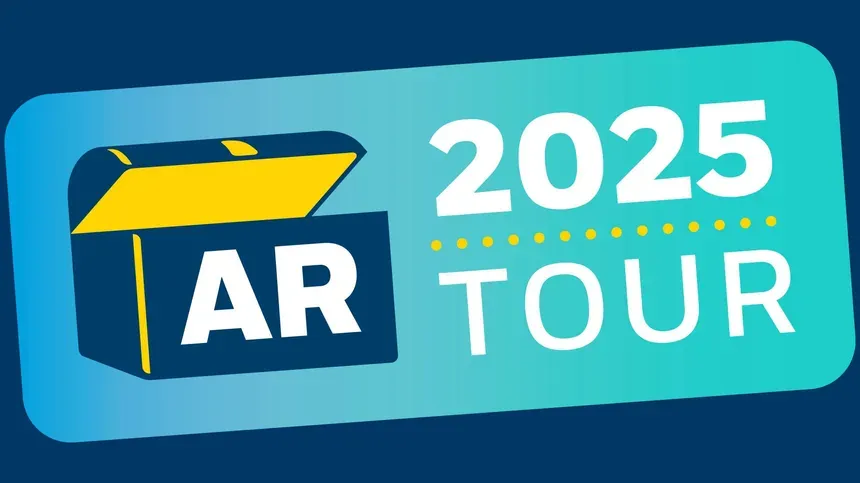
ANTIQUES ROADSHOW 2025 Tour!
Enter now for a chance to win free tickets to ANTIQUES ROADSHOW's 2025 Tour! Plus, see which cities we're headed to!Providing Support for PBS.org
Learn Moreabout PBS online sponsorshipMore from This Collection
RECUT: Idaho Botanical Garden, Part 4
Video has Closed Captions
Wrap up Season 4 of RECUT with a $50,000 appraisal at Idaho Botanical Garden! (22m 31s)
RECUT: Idaho Botanical Garden, Part 3
Video has Closed Captions
Visit the “City of Trees” for unbe-leaf-able Boise treasures in this half-hour RECUT. (22m 31s)
RECUT: Idaho Botanical Garden, Part 2
Video has Closed Captions
In this half-hour RECUT, watch breathtaking Boise appraisals at Idaho Botanical Garden. (22m 31s)
RECUT: Idaho Botanical Garden, Part 1
Video has Closed Captions
Gem State treasures sparkle in this half-hour RECUT at Idaho Botanical Garden! (22m 31s)
Video has Closed Captions
Watch wow-worthy Woodside finds in this half-hour RECUT and learn which is up to $44,000! (22m 24s)
Video has Closed Captions
In this half-hour RECUT episode, golden state treasures shine at Filoli. One is $150,000! (22m 23s)
Video has Closed Captions
Watch fascinating Filoli finds in this half-hour RECUT, including one up to $100,000! (22m 36s)
Video has Closed Captions
This season's first half-hour of RECUT wows our guests with a $200,000 to $330,000 find! (22m 30s)
RECUT: American Stories, Part 1
Video has Closed Captions
Learn the stories of objects that represent American traditions and triumphs! (22m 28s)
RECUT: Desert Botanical Garden, Part 2
Video has Closed Captions
Phoenix treasures heat up, like one appraisal up to $35,000, in this half-hour RECUT! (22m 28s)
RECUT: Desert Botanical Garden, Part 1
Video has Closed Captions
Phenomenal Phoenix finds abound in this half-hour RECUT. One is worth up to $100,000! (22m 26s)
RECUT: Crocker Art Museum, Part 2
Video has Closed Captions
See stunning Sacramento finds like one $80,000-$125,000 treasure, in this half-hour RECUT! (22m 28s)
Providing Support for PBS.org
Learn Moreabout PBS online sponsorship♪ ♪ CORAL PEÑA: "Antiques Roadshow Recut" is celebrating women makers, movers, and shakers.
The turn of the century, to have a mother who was a doctor is just amazing.
PEÑA: Stay tuned for these moments and more, It's "Antiques Roadshow Recut: Women's Work Part 1."
♪ ♪ PEÑA: "Antiques Roadshow Recut" is looking back at the work of women who made art...
This is one of the greatest pieces of Newcomb College I have ever seen.
PEÑA: ...made history... She's a very important figure in aviation history, she's a very important figure in women's history.
PEÑA: ...or both!
APPRAISER: Margaret Bourke-White was a woman of many firsts.
PEÑA: First up, it's the baseball collection of one trailblazing athlete of the 1950s.
Okay, put on that glove-- I want to see what you do.
Hmm, babe!
Scrunch down.
That's right.
That all right?
This is you, circa 1951.
How did you drop down into the All-American Professional Girls Baseball League?
I went to visit a friend and a cousin in Fort Wayne, Indiana.
He said, "How would you like to go see the Fort Wayne Daisies play baseball tonight?"
And being a softball player myself and having played baseball with the boys, I said, "What a great idea-- let's go."
At the end of the ninth inning, I turned to him and I said, "You know, I can do that."
The next day, I had a tryout with the Fort Wayne Daisies, with Max Carey, right here.
Great center fielder, Hall of Famer.
And four or five of the Fort Wayne Daisies at the time.
And at the end of the hour or hour and a half, he said to me, "Lois, we'll call you."
(laughs) "We will let you know."
Wow.
In January, I received a letter inviting me to spring training in Alexandria, Virginia.
And off I went.
17 years old.
Got special dispensation from the county superintendent to get out of school.
Wow.
And how long did you play for?
Four years.
The league folded, actually, in 1954.
Right, disbanded.
Bill Allington, he was one of the longtime, very, very great managers in the league-- and he said, "I am going to take "a group of former players in the league, and we're going to barnstorm."
We're gonna play against men."
How did you do?
I was just happy that every night I didn't get killed.
And you've brought your collection, some of your collection-- there's much more...
Yes, yes.
...from your time with the All-American Girls Baseball League.
I know you played for two teams, the Daisies, and you played also for, uh, the Blue Sox, correct?
Blue Sox, yes, yes.
South Bend.
This is when you played with the Daisies.
Here you are, and Jimmie Foxx is right here.
He was your manager.
He managed for one year.
That's right.
Jimmie Foxx, another great Hall of Famer.
And I believe Jimmie Foxx was pretty much the, the figure that they used to base Tom Hanks' character in "A League of Their Own."
Now, was he really like that?
No-- if I had an opportunity to set the record straight, I don't think there was a player on the Fort Wayne team that did not adore Jimmie Foxx.
The All-American Girls Professional Baseball League got started in 1943, when the Major League players, many of them, went off to war, and Philip K. Wrigley, who was the, uh, chewing gum magnate...
Yes.
Started it so they could maintain baseball in the public eye.
And I see they made the women at that time wear these spiffy outfits.
Yes.
Which today would almost be considered miniskirts.
So there's your catcher's mitt that you caught the game.
This is your original cap.
That's your jacket with the original patches.
This is an example of a ball that they used in later years.
The ball kept changing, getting smaller.
Yes.
From 12 inches to nine inches.
We have the championship photo signed by Jimmie Foxx and the entire team.
This is a facsimile of an actual program that you have signed to you by Jimmie Foxx.
Your patch, the photo of you at 17 with Clark Griffith and Max Carey and the other lady who didn't make the team.
Yeah, I have no idea who she is.
Right.
Plus, we have your scrapbook that we're not showing.
We have other photos, we have a locket from you.
We have other programs-- it's a treasure trove.
I would put an auction estimate on the entire grouping of about $10,000.
I'm surprised.
Not bad for a girl baseball player.
Not... Not bad for a 17-year-old that didn't know where New York City was.
WOMAN: This belonged to my great-great-aunt, Ruth Muskrat Bronson.
She was a civil rights activist.
She was an author, a poet, a songwriter, an educator.
To me, she is so special.
She was a woman before her time.
And she did a lot of things for Native American people that we can all still be proud of today.
What was her era, so to speak?
She was born in 1897.
This picture was taken in 1923 when she was a junior in college at Mount Holyoke.
And this is at the White House.
Okay.
In Washington, D.C.
This is my aunt Ruth, and this is President Calvin Coolidge.
And this is a book that she presented to him that day.
And she also gave a speech that day.
Is the dress that you're standing by the one she's wearing in that photograph?
This is the dress that's in the photograph, yes.
Okay.
And, and that's the same dress that's in this photograph.
Were the moccasins and the dress created for the presidential event?
That's my understanding, yes.
They were intentionally not Cherokee items.
Mm-hmm.
So that she could be representative of more than just her tribe, and be representative of all American Indians.
This is the speech that she delivered at the White House, is that right?
Yes.
And to read through that speech, it gives me goose bumps.
She said a lot of really amazing things in that speech.
And she said such amazing things that President Coolidge invited her to come to the White House for lunch at a later date, which she did.
In the speech, she tells who made the beadwork, who did these things.
And both the moccasins and the dress were made here in Oklahoma by Cheyenne beadworkers.
The hides are brain-tanned deerskin, which were never inexpensive.
they were difficult to make.
And I thought the moccasins might be Lakota, because of the designs.
But then I got to looking, and there's a welt between the sole and the beaded uppers.
You notice that trait in lots of Cheyenne moccasins from Oklahoma-- the southern Cheyennes.
Do you know what she was talking to the president for?
Well, this was the Committee of One-Hundred in 1923.
And I believe she was asking for civil rights for Native American people.
Right.
And also fighting for Native Americans in the laws that were being created at that time and talking about "the Indian problem."
And she wanted the president to hear from an Indian what the real Indian problem was, and it wasn't what the other people were calling the Indian problem.
She wanted everyone to accept Native Americans as Americans and to allow them to be educated just like everyone else.
Where did she live?
She was from Grove, Oklahoma.
and that's where our whole family was from.
That's where our allotment land, uh... We still have that allotment land.
But she, she lived in Washington, D.C. She worked there for the government, for the B.I.A., and then she retired in, uh, Phoenix, Arizona.
She was helping different tribes her entire life.
When she passed away, I believe she was in Arizona working for water rights for tribes out there.
Oh, yeah, that's a big deal.
Yes.
She's asking for what we consider basic human rights in this country today...
Absolutely.
...in the '20s.
And, and after that, you get the Depression, and things really got bleak.
Now people have awakened to these situations, but they didn't do it without a pushback.
And that's why a lot of rules have been passed, laws have been enacted, everything from the Native American sovereignty acts to NAGPRA, the Native American Graves Protection and Repatriation Acts.
And they protect this cultural patrimony that's been handed down, in your case, through your family, but also in national input.
And this was the early days of all that.
These were the people that pushed that to try to make it happen.
When you brought this dress in and the moccasins, I looked at it and I said, "Yeah, nice moccasins, nice dress."
In this condition, and mainly because they're late, if you were gonna see these things at auction, you'd expect them to bring $800 to $1,200, but that's not what's here.
That's not what this is about.
This woman wore these things to represent a pan-culture, almost, that spread across the United States, that she was fighting for, for rights for.
When you start looking at it from that point of view-- her meeting with the president, the original speech-- I think you're talking, for all that you have here, and you have more, you have more archival material, more photographs, if you were to bring these up for insurance, I think it's more like $8,000 to $12,000.
Wow.
And these things are priceless to our family.
Oh, I'm sure.
So, yes.
It is exciting to see it, because it really is Chanel.
The label is exactly right.
Oh, yes.
This is not just Chanel, this is Chanel Couture.
It is a whole nother level of value, because this garment was custom-designed, custom-made.
If you were to go to a major auction or a major dealer to buy a piece like this, you would expect to pay somewhere between $25,000 and $30,000 for this coat.
Wow.
Isn't that cool?
Yes, it is.
I have a collection of letters, personal letters, uh, from Amelia Earhart to my aunt, along with a telegram sent to my aunt and her husband when Amelia landed in England on her solo crossing.
When my aunt passed away, she left them to me.
My aunt's introduction to the aviation community was through her soon-to-be husband, Porter.
Porter Adams was part of the early aviation crowd, and when they started dating, she was included in that group.
They were close enough so that Amelia agreed to be her maid of honor.
And did your aunt tell you any interesting stories about Amelia Earhart?
She had a great admiration for her.
She'd talk about the last flight she made, which we're, they're-- we're still looking for her.
And said that, uh, most of her friends were trying to discourage it because, technically, she wasn't the most proficient pilot.
She was just a great adventurer, tremendous courage, and just had that spirit.
And they were concerned because this was a very technical flight.
The navigators, everybody knows, had some history with, you know, some problems.
And the equipment, including the radio, we later found out, wasn't very good.
So they were, they were concerned that maybe this was a little bit too risky.
The great thing about this collection of letters is that it shows us what some of her other talents are.
I think one of the things she had a talent for was public relations.
She was a great controller of her image, of the message.
And the other thing was, she had an incredible entrepreneurial spirit.
You have an archive of about eight letters.
There are four typed letters, four handwritten letters.
This one's written on the letterhead of the New York, Philadelphia, Washington Airway Corporation, which, we learn from a later letter, she had a role as vice president of public relations for this.
And in this letter, she's talking to your uncle about trying to get involved in selling swimming pools.
"Let me know if you think it's a hot idea, and maybe you'll know someone who can dump in some cash," says the letter.
(laughs) The other letter, over here, this typed letter, is on Hearst International "Cosmopolitan" magazine letterhead, and it reminds us of her role as a journalist.
She's the aviation editor at "Cosmopolitan."
And the other letters, too, indicate all of the interests and entrepreneurial efforts that she was involved in in promoting aviation.
She's a very important figure in aviation history.
She's a very important figure in women's history.
Letters are more valuable than telegrams, in general.
Although that's an interesting telegram on its own.
I would value the collection with an auction estimate of $12,000 to $18,000.
Very nice.
Excellent.
APPRAISER: Margot de Taxco started doing enamel work in the late 1950s, and was one of the few women jewelers working in Mexico at the time.
This is highly collectible.
I would say the value of this snake bracelet is around $800.
Great, thank you.
♪ ♪ WOMAN: Well, I inherited this painting from my paternal aunt, and she and her husband would travel down from New York City to Natchitoches, Louisiana, to visit his family.
And they just loved these paintings by "Clementeen" Hunter, is what I'm told, is how she pronounced her name.
She was known as the Grandma Moses of the South.
This is great.
You got the blackbirds.
Mm-hmm.
You got the goose pulling on the little girl's dress there.
Yes, and the dogs.
My Aunt June always... We loved the way she made those old dogs look.
One that size, with subject matter that interesting and that colorful, would probably, retail, be about $6,000.
Really?
(chuckles) Wow, that's great.
That's great.
Cool.
When you were standing in line and brought this doctor's bag, I couldn't wait to see what you were gonna pull out of it.
But little did I expect you were gonna pull out an earlier doctor's bag, which is full of all kinds of obstetrical equipment from the turn of the century.
Can you tell me a little bit about how you got this?
This was my mother's.
She was born in 1882.
Mm-hmm.
This bag you see here was her first original doctor's bag.
My grandmother wove this material.
She graduated from the Royal University of Messina.
It was very, very unusual for women... Mm-hmm.
...to be graduated at that time with her degree.
Well, I mean, we think right now of the strides that women have made, but at the turn of the century...
Yes, yes.
To have a mother who was a doctor and an obstetrician is just, is just amazing.
You brought her diploma, her certificate of health from New York City, and a wonderful picture of her.
Thank you.
But tell me a little bit of some of the other things.
You have a list of all the births that she did, as well?
Well, she kept a record of all of them.
This is a wonderful record of all of these births, and it carried all sorts of things-- very early stethoscope... A wooden stethoscope.
A wooden stethoscope.
Some very early painkillers.
Medication.
And medications.
Medical collectibles right now are becoming very, very popular.
They're being collected by doctors, mostly.
Yes.
But to have a female doctor from 1905, who-- and all of the equipment that went with her-- is just a phenomenal archive to have saved.
Do you have any idea what this might be worth?
Uh, no, I didn't get a full appraisal on it, actually.
Mm-hmm.
Um, I'm assuming that the stethoscope is very valuable.
Well, this would be your most valuable piece, and sometimes these sell for as much as $800 to $1,200.
But I would value everything that you have here in your collection at $3,000 to $5,000.
Oh, my-- my mother would be surprised.
(laughs): She would be surprised.
Well, a lot of very happy babies and mothers were made from this little bag.
Never lost a mother, never lost a baby.
(laughs) And she had a great deal of compassion.
MAN: This is a photograph that was given to my aunt right at the end of the Second World War by Margaret Bourke-White.
They met each other in, in Europe.
My aunt was working with the displaced persons at the end of the war-- in fact, my aunt was very senior in the administration-- and many millions of people they had to relocate back to homes that were thousands of miles, I guess, from, from where they'd been forced to flee from.
So, what part of Europe did your aunt work in?
She talked about France and Germany.
I think most of the time, she was in Germany.
Well, your aunt sounds like a remarkable woman, and Margaret Bourke-White was a remarkable woman, as well.
She was a woman of many firsts.
She was the first woman photographer to be hired by Henry Luce for "Fortune" magazine.
Okay.
She was the first American photojournalist to go to Russia, in 1930.
She was the first photographer to have a cover image on "Life" magazine, in 1936.
Ah.
And during the Second World War, she was the first woman combat photographer.
But if we go back and look at this picture, what you have is a picture of the George Washington Bridge during construction...
Okay.
That she did as part of a photo essay for "Fortune" magazine, which was the first American magazine to really focus on the industrial landscape, the corporate landscape.
And what Margaret Bourke-White brought to her images was a very sophisticated sensibility that drew on a Modernist aesthetic, an artistic aesthetic, but also an appreciation for the machine, for the industrial age.
You have a vintage photograph, which, of course, is the preferred photograph, was done in 1933.
And if we look at the edges, we see that they have this black border.
Oh.
This is characteristic of what Bourke-White elected in her exhibition prints.
The picture is, of course, mounted, and she has her penciled signature, which indicates it is a final print, an exhibition print.
At auction, an estimate would be $20,000 to $30,000.
Wow.
It's probably one of Margaret Bourke-White's ten best photographs.
Really?
Thank you so much for bringing it in.
Wow, that's... that's amazing.
I wouldn't have had any idea that it was worth that.
When you walked in, the blood started coursing through my veins.
(chuckling): I saw that-- I saw that.
WOMAN: My mom gave this, what is now a vase-- it used to be a lamp-- to me.
It was my great-grandmother's.
And she had it in her house as a lamp for many, many years.
And when she went to the retirement home, my mom got to pick it out, and brought it home with her.
A couple of years ago, she got two young boy cats, and they were playing in the house, and she came home, and it was knocked off, and it had broken the lamp shade, but luckily, the vase was completely intact.
And a friend of ours had come in to the house that works at UTC in the art department, and had said, "That's a Newcomb Pottery vase.
"I think you need to get it checked out and see what it is."
This was indeed done at Newcomb College Pottery.
It was done by one of their artists, Leona Nicholson.
Okay.
And I could tell that because her mark is down here, along with the Newcomb College mark.
She was a student at Newcomb College in 1896 to '97.
All right.
Then, she went to the New York State Ceramic School at Alfred University.
Oh.
And that is a very prestigious school.
Okay.
And then she came back to Newcomb College, and was there between about 1908 and the late '20s.
And she would have done this in about 1908.
Okay.
These are known as late glossy or carved glossy pieces.
It has everything that you want in a piece of Newcomb College.
This is one of the greatest pieces of Newcomb College I have ever seen.
Yay.
And I've seen a lot of them, okay?
(laughs): Well, that's wonderful.
It's glossy, it's carved, it's tall, it has orange, which is so rare.
Really?
It has these beautifully stylized trees.
It's awesome.
Wonderful.
Okay?
I've always loved it.
I think it's an absolutely beautiful piece of pottery.
Now, you said somebody turned it into a lamp.
It has a hole in the base, and it was a lamp, as we saw it, growing up.
And we thought that maybe the fact that it had been turned into a lamp would have devalued the piece.
Yes, it did devalue.
It's still worth, at auction, from $30,000 to $40,000.
Really?
In this condition.
It would probably be worth about twice as much... Oh, my gosh.
Had it not been drilled.
Oh, no-- well, still, that's a lot for a vase that's been in our family.
It'll stay in our family.
It's been an heirloom passed down, and I wouldn't ever think of parting with it.
Thank you very much.
♪ ♪ PEÑA: Thanks for watching, we hope you've enjoyed this episode of "Antiques Roadshow Recut."
Appraisal: 1933 Margaret Bourke-White Photograph
Video has Closed Captions
1933 Margaret Bourke-White Photograph (2m 51s)
Appraisal: 1940 Emma Bourne Pictorial Map
Video has Closed Captions
Appraisal: 1940 Emma Bourne Pictorial Map (32s)
Appraisal: 1971 Clementine Hunter Painting
Video has Closed Captions
Appraisal: 1971 Clementine Hunter Painting (58s)
Appraisal: Amelia Earhart Letter Archive, ca. 1930
Video has Closed Captions
Appraisal: Amelia Earhart Letter Archive, ca. 1930 (3m 7s)
Appraisal: Girl's Pro Baseball League Collection, ca. 1950
Video has Closed Captions
Appraisal: Girl's Pro Baseball League Collection, ca. 1950 (3m 39s)
Appraisal: Maria Martinez Pot & Diary, ca. 1930
Video has Closed Captions
Appraisal: Maria Martinez Pot & Diary, ca. 1930 (32s)
Appraisal: Physician's Group, ca. 1905
Video has Closed Captions
Appraisal: Physician's Group, ca. 1905 (2m 34s)
Providing Support for PBS.org
Learn Moreabout PBS online sponsorshipFunding for ANTIQUES ROADSHOW is provided by Ancestry and American Cruise Lines. Additional funding is provided by public television viewers.


